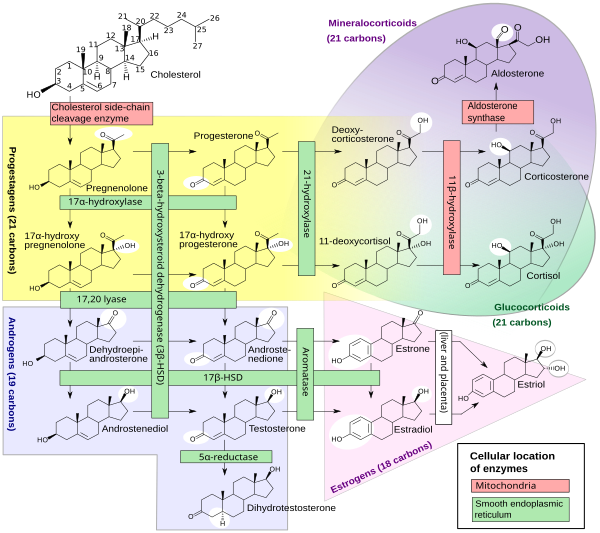프로게스테론
보이기

| |

| |
| 이름 | |
|---|---|
| IUPAC 이름
(8S,9S,10R,13S,14S,17S)-17-acetyl-10,13-dimethyl-1,2,6,7,8,9,11,12,14,15,16,17-dodecahydrocyclopenta[a]phenanthren-3-one
| |
| 별칭 | |
| 식별자 | |
3D 모델 (JSmol)
|
|
| ChEBI | |
| ChEMBL | |
| ChemSpider | |
| DrugBank | |
| ECHA InfoCard | 100.000.318 |
| KEGG | |
PubChem CID
|
|
| UNII | |
CompTox Dashboard (EPA)
|
|
| |
| |
| 성질 | |
| C21H30O2 | |
| 몰 질량 | 314.469 g/mol |
| 녹는점 | 126 |
| log P | 4.04[4] |
| 약리학 | |
| G03DA04 (WHO) | |
| By mouth, topical/transdermal, vaginal, intramuscular injection, subcutaneous injection, subcutaneous implant | |
| 약물동태학: | |
| OMP: <10%[5][6] | |
| • Albumin: 80% • CBG: 18% • SHBG: <1% • Free: 1–2%[7][8] | |
| Hepatic (CYP2C19, CYP3A4, CYP2C9, 5α-reductase, 3α-HSD, 17α-hydroxylase, 21-hydroxylase, 20α-HSD)[9][10] | |
| OMP: 16–18 hours[5][6][11] IM: 22–26 hours[6][12] SC: 13–18 hours[12] | |
| Renal | |
달리 명시된 경우를 제외하면, 표준상태(25 °C [77 °F], 100 kPa)에서 물질의 정보가 제공됨.
| |
프로게스테론(progesterone, P4)은 여성의 호르몬 중 하나이다. 여포 자극 호르몬(follicle stimulating hormone, FSH), 황체 형성 호르몬(luteinizing hormone, LH), 에스트로겐(estrogen)과 함께 여성의 생식 주기를 조절한다. 월경 시작일 기준으로 1~14일을 여포기(follicular phase), 14~28일을 황체기(luteal phase)라고 한다.
생화학적 합성 경로
[편집]같이 보기
[편집]- 에스트로겐(estrogen)
각주
[편집]- ↑ Jameson, J. Larry; De Groot, Leslie J. (2015년 2월 25일). 《Endocrinology: Adult and Pediatric E-Book》. Elsevier Health Sciences. 2179쪽. ISBN 978-0-323-32195-2.
- ↑ Adler, Norman; Pfaff, Donald; Goy, Robert W. (2012년 12월 6일). 《Handbook of Behavioral Neurobiology Volume 7 Reproduction》 1판. New York: Plenum Press. 189쪽. ISBN 978-1-4684-4834-4. 2015년 7월 4일에 확인함.
- ↑ “progesterone (CHEBI:17026)”. 《ChEBI》. European Molecular Biology Laboratory-EBI. 2015년 7월 4일에 확인함.
- ↑ “Progesterone_msds”.
- ↑ 가 나 Stanczyk FZ (September 2002). “Pharmacokinetics and potency of progestins used for hormone replacement therapy and contraception”. 《Reviews in Endocrine & Metabolic Disorders》 3 (3): 211–24. doi:10.1023/A:1020072325818. PMID 12215716. S2CID 27018468.
- ↑ 가 나 다 Simon JA, Robinson DE, Andrews MC, Hildebrand JR, Rocci ML, Blake RE, Hodgen GD (July 1993). “The absorption of oral micronized progesterone: the effect of food, dose proportionality, and comparison with intramuscular progesterone”. 《Fertility and Sterility》 60 (1): 26–33. doi:10.1016/S0015-0282(16)56031-2. PMID 8513955.
- ↑ Fritz, Marc A.; Speroff, Leon (2012년 3월 28일). 《Clinical Gynecologic Endocrinology and Infertility》. Lippincott Williams & Wilkins. 44–쪽. ISBN 978-1-4511-4847-3.
- ↑ Marshall, William J.; Marshall, William J.; Bangert, S. K. (2008). 《Clinical Chemistry》. Elsevier Health Sciences. 192–쪽. ISBN 978-0-7234-3455-9.
- ↑ Yamazaki H, Shimada T (October 1997). “Progesterone and testosterone hydroxylation by cytochromes P450 2C19, 2C9, and 3A4 in human liver microsomes”. 《Archives of Biochemistry and Biophysics》 346 (1): 161–9. doi:10.1006/abbi.1997.0302. PMID 9328296.
- ↑ McKay, Gerard A.; Walters, Matthew R. (2013년 2월 6일). 《Lecture Notes: Clinical Pharmacology and Therapeutics》. John Wiley & Sons. 33쪽. ISBN 978-1-118-34489-7.
- ↑ Zutshi (2005년 1월 1일). 《Hormones in Obstetrics and Gynaecology》. Jaypee Brothers Publishers. 74쪽. ISBN 978-81-8061-427-9.[깨진 링크(과거 내용 찾기)]
- ↑ 가 나 Cometti B (November 2015). “Pharmaceutical and clinical development of a novel progesterone formulation”. 《Acta Obstetricia et Gynecologica Scandinavica》 94 (Suppl 161): 28–37. doi:10.1111/aogs.12765. PMID 26342177. S2CID 31974637.

